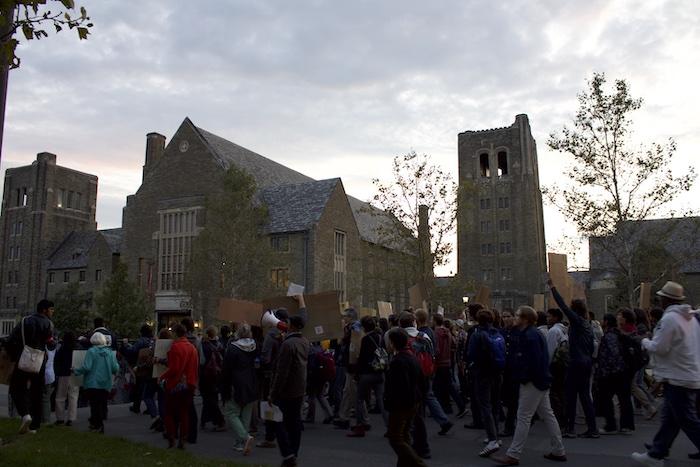
Cornell University has undertaken a large housing expansion project to accommodate a rising student population. It would fix a list of problems for both the university and the City of Ithaca, but some students and community members have questions about its potential environmental impact.
By adding 2,000 more beds and a dining hall, the North Campus Residential Expansion project would allow the university to house 100% of its first-year and sophomore students. This would alleviate some pressure on the residential areas surrounding campus, already congested by about 15,000 Cornell students.
Project leaders have submitted data to the City of Ithaca concerning the new buildings’ energy-use. But members of Climate Justice Cornell, a student organization, circulated a petition that accumulated over 600 signatures, calling for a complete environmental impact statement. Those who signed the petition include other students, faculty, alumni and local activists.

CJC’s members are demanding that the impact statement include a comprehensive evaluation of the project’s greenhouse gas emissions, and specifically that it account for upstream methane emissions.
Upstream methane emissions refer to the leakage of methane when natural gas, which currently powers Cornell’s Central Energy Plant, is transported from the fracking-site to the university.
“Methane is a really big deal,” said Julie Kapuvari, CJC general body organizer and a senior environmental and sustainability sciences major. “Like carbon dioxide, [methane] is a greenhouse gas, so it directly contributes to climate change. But over a decade, it is 100 times more potent than carbon dioxide.”
Upstream leakage is a relatively new layer to the evaluation of greenhouse gas emissions, but some of the leading researchers on the topic work right at Cornell. That’s why Guillermo Metz, Energy Team Leader with Cornell Cooperative Extension of Tompkins County, feels that the school should be “held to a higher standard.”
“If they wanted to, they could be more cutting edge,” Metz said.

Questions have also been raised concerning the efficiency of the building’s design. Using LEED, a system for evaluating the sustainability and efficiency of buildings, the current design meets Gold standards, the second-highest rating. The residence halls are also designed to achieve energy-use thirty-percent lower than the State Energy Code standards.
However, critics say that these figures are not as impressive as they may sound.
“Thirty percent [below the State standard] is not hard to achieve,” said Metz, noting that the State Energy Code has not been updated since 2009.
And members of the CJC are unimpressed with the design’s LEED Gold certification.
“We don’t even think LEED Platinum [the highest rating] is comprehensive,” Kapuvari said.
The window-to-wall ratio that has been proposed is another central point of concern for the CJC. The current design has a window-to-wall ratio of 22%, but the optimum ratio is 15%, meaning that 15% of any wall should be a window.
Though larger windows allow for more sunlight to enter a building, they also let heat to escape buildings more easily.
One of the university’s defenses of the larger windows has been that more natural light would be beneficial to students’ mental health.
“To be candid, Cornell can do a lot more for [students’] mental health than bigger window sizes,” said Zoya Mohsin, a sophomore member of CJC, suggesting that the university instead invest in resources that will give students easier access to mental health professionals.
Gabriela Vega, a senior member of CJC, said that there has been a lack of dialogue regarding the feasibility of improving mental health via larger windows.
At this point, neither city nor university spokespeople have said whether or not they will consider these demands.
In response to a request for comment regarding its students criticisms of the project, Cornell reiterated its official position summarized in a recent Cornell Chronicle story: “The project was guided by the findings of the 2016 housing master plan, which was based on months of conversations with students, alumni, staff, faculty and community members about student housing needs… Conversations with the local community and campus have continued since then and will be ongoing.”
Those with questions about the project’s environmental impact are encouraged to visit the project’s homepage, as well as its frequently asked questions page.
Critics of the expansion said that the expansion’s effects, good or bad, will be far-reaching.
“The bigger issue is increasing the community’s understanding of the necessity to transition off fossil fuel… Our buildings need to be more responsible,” Metz said.
Mohsin echoed this sentiment: “This should set the precedent for future buildings. If we let this one just slide, that’s a lot of people being affected… Not only now, but in the future.”

















